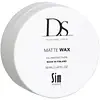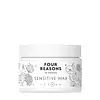What's inside
What's inside
 Key Ingredients
Key Ingredients

 Benefits
Benefits

 Concerns
Concerns

 Ingredients Side-by-side
Ingredients Side-by-side

Water
Skin ConditioningParaffin
PerfumingKaolin
AbrasivePropanediol
SolventTrilaureth-4 Phosphate
EmulsifyingBis-Diglyceryl Polyacyladipate-2
EmollientVp/Va Copolymer
Glycerin
HumectantGlyceryl Stearate
EmollientPEG-100 Stearate
Ceteareth-30
CleansingDimethicone
EmollientCetyl Alcohol
EmollientHydrogenated Coco-Glycerides
EmollientPolyquaternium-55
PEG-7 Glyceryl Cocoate
EmulsifyingSodium Polyacrylate
AbsorbentCyclopentasiloxane
EmollientEthylhexyl Methoxycinnamate
UV AbsorberTrideceth-6
EmulsifyingPhenoxyethanol
PreservativeEthylhexylglycerin
Skin ConditioningPiroctone Olamine
PreservativeCaprylyl Glycol
EmollientPEG/PPG-18/18 Dimethicone
EmulsifyingWater, Paraffin, Kaolin, Propanediol, Trilaureth-4 Phosphate, Bis-Diglyceryl Polyacyladipate-2, Vp/Va Copolymer, Glycerin, Glyceryl Stearate, PEG-100 Stearate, Ceteareth-30, Dimethicone, Cetyl Alcohol, Hydrogenated Coco-Glycerides, Polyquaternium-55, PEG-7 Glyceryl Cocoate, Sodium Polyacrylate, Cyclopentasiloxane, Ethylhexyl Methoxycinnamate, Trideceth-6, Phenoxyethanol, Ethylhexylglycerin, Piroctone Olamine, Caprylyl Glycol, PEG/PPG-18/18 Dimethicone
Water
Skin ConditioningKaolin
AbrasivePetrolatum
EmollientBis-Diglyceryl Polyacyladipate-2
EmollientCetyl Alcohol
EmollientVp/Va Copolymer
Ceteareth-25
CleansingPEG-40 Hydrogenated Castor Oil
EmulsifyingCopernicia Cerifera Cera
EmollientAlcohol Denat.
AntimicrobialSynthetic Wax
AbrasiveHydrogenated Microcrystalline Wax
Emulsion StabilisingBambusa Vulgaris Sap Extract
EmollientGlycerin
HumectantPropylene Glycol
HumectantEthylhexylglycerin
Skin ConditioningPolysorbate 20
EmulsifyingPhenoxyethanol
PreservativeWater, Kaolin, Petrolatum, Bis-Diglyceryl Polyacyladipate-2, Cetyl Alcohol, Vp/Va Copolymer, Ceteareth-25, PEG-40 Hydrogenated Castor Oil, Copernicia Cerifera Cera, Alcohol Denat., Synthetic Wax, Hydrogenated Microcrystalline Wax, Bambusa Vulgaris Sap Extract, Glycerin, Propylene Glycol, Ethylhexylglycerin, Polysorbate 20, Phenoxyethanol
Ingredients Explained
These ingredients are found in both products.
Ingredients higher up in an ingredient list are typically present in a larger amount.
This ingredient is lipid-based synthetic skin-conditioning agent derived from adipic acid and a mixture of fatty acids. It is often called a lanolin substitute.
As an emollient, it helps soften and hydrate the skin. Emollients create a barrier on the skin to trap moisture in.
Due to its fatty acid base, it may not be Malassezia folliculitis safe.
Learn more about Bis-Diglyceryl Polyacyladipate-2Cetyl Alcohol is a fatty alcohol. Fatty Alcohols are most often used as an emollient or to thicken a product.
Its main roles are:
Though it has "alcohol" in the name, it is not related to denatured alcohol or ethyl alcohol.
The FDA allows products labeled "alcohol-free" to have fatty alcohols.
Learn more about Cetyl AlcoholEthylhexylglycerin (we can't pronounce this either) is commonly used as a preservative and skin softener. It is derived from glyceryl.
You might see Ethylhexylglycerin often paired with other preservatives such as phenoxyethanol. Ethylhexylglycerin has been found to increase the effectiveness of these other preservatives.
Glycerin is already naturally found in your skin. It helps moisturize and protect your skin.
A study from 2016 found glycerin to be more effective as a humectant than AHAs and hyaluronic acid.
As a humectant, it helps the skin stay hydrated by pulling moisture to your skin. The low molecular weight of glycerin allows it to pull moisture into the deeper layers of your skin.
Hydrated skin improves your skin barrier; Your skin barrier helps protect against irritants and bacteria.
Glycerin has also been found to have antimicrobial and antiviral properties. Due to these properties, glycerin is often used in wound and burn treatments.
In cosmetics, glycerin is usually derived from plants such as soybean or palm. However, it can also be sourced from animals, such as tallow or animal fat.
This ingredient is organic, colorless, odorless, and non-toxic.
Glycerin is the name for this ingredient in American English. British English uses Glycerol/Glycerine.
Learn more about GlycerinKaolin is a clay. It is used for oil control and to help minimize pores. Like other clays, kaolin has the ability to absorb excess sebum or oil. This can help clean out pores and mattify the skin.
Some types of kaolin may have exfoliating properties. When water is added to kaolin, it becomes a paste with small abrasive particles.
Most kaolin is a white color, but may be pink/orange/red depending on where it comes from.
The name 'kaolin' comes from a Chinese village named 'Gaoling'. Kaolin clay comes from rocks rich in kaolinite. Kaolinite, the mineral, has a silicate layered structure. Kaolinite is formed from chemical weathering of aluminum siilicate minerals.
Besides skincare, kaolin is commonly used to make glossy paper, in ceramics, toothpaste, and as medicine to soothe stomach issues.
Learn more about KaolinPhenoxyethanol is a preservative that has germicide, antimicrobial, and aromatic properties. Studies show that phenoxyethanol can prevent microbial growth. By itself, it has a scent that is similar to that of a rose.
It's often used in formulations along with Caprylyl Glycol to preserve the shelf life of products.
We don't have a description for Vp/Va Copolymer yet.
Water. It's the most common cosmetic ingredient of all. You'll usually see it at the top of ingredient lists, meaning that it makes up the largest part of the product.
So why is it so popular? Water most often acts as a solvent - this means that it helps dissolve other ingredients into the formulation.
You'll also recognize water as that liquid we all need to stay alive. If you see this, drink a glass of water. Stay hydrated!
Learn more about Water